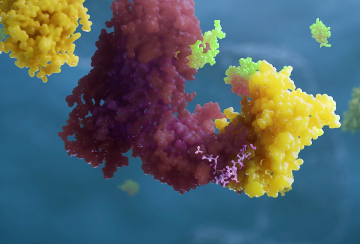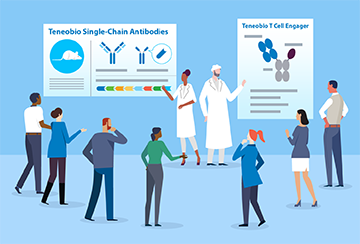WATCH: Hear from three of our experts about how Amgen Oncology is using biotechnology to drive the future of cancer.
For most of human history, medicine has been based in biochemistry — with healers and scientists alike using both naturally occurring and synthesized chemical compounds to create therapeutic effects in the body. Around the turn of the 21st century, medicine began an accelerated shift into what Amgen CEO Bob Bradway calls the “biocentury,” in which medicine is increasingly derived not from chemical compounds, but from bioengineered living cells informed by a rapidly expanding knowledge of human genetics.
The early days of biotech emerged in the 1970s and 1980s with the development of recombinant DNA technology, an early form of genetic engineering in which scientists combined genetic sequences from different organisms in novel ways to help patients treat or manage certain diseases.
Today, as Amgen approaches its 40th anniversary, the biotech industry it helped build has grown significantly more sophisticated, and the unique skillset of biotechnology has become a backbone of modern precision cancer medicine. Today, oncologists can personalize treatment plans using information found within patients’ own genetic codes. They can target specific DNA mutations found in tumors themselves, and they can empower some patients’ own immune systems to attack cancer cells.
Faced with an incredible need and drive for innovation in oncology, biotech researchers around the world painstakingly investigate new potential treatment modalities, from immunotherapies and small molecules that target specific mutations in tumor DNA, to genetically modified viruses that deliver cancer-fighting agents into cancer cells, and the development of flexible treatment platforms that can evolve to meet the needs of individual patients.
Focusing on hard to treat cancers
Every year, 9.6 million people around the world lose their lives to cancer, and countless more have their lives turned upside down. And it’s not just patients who suffer — alongside every cancer patient is a community of impacted loved ones offering their support. “Cancer is a disease that often robs a person of the most productive years of their life,” says Greg Friberg, vice president of Global Development at Amgen. “We want to focus on giving that back.”
With 40 years of experience in biotechnology, Amgen seeks to turn the tide for as many people as possible by focusing on areas of high unmet need, and by contributing to global scientific advancements in order to quickly bring new innovative therapies to patients.
“I do believe we're at the dawn of a very new age. We have the right type of technology to get there,” says PK Morrow, vice president of Global Development at Amgen. “But we also have the right collaborative spirit across the globe, with scientists, clinicians, physicians — all of us — holding hands and working together to collaborate and share knowledge.”
At Amgen, work is underway to identify and test investigational therapies for a range of malignancies with high unmet need, like glioblastoma and thoracic cancer.
Shooting for the moon
Surgery, chemotherapy and radiation therapy have been the backbone of cancer care since the 1940s, and while these modalities have grown incredibly sophisticated over the years, biotech companies must look beyond incremental advances to existing therapies, and toward the development of new modalities.
Companies like Amgen have a responsibility to shoot for the moon, committing significant resources and intellectual investments to uncover potential novel therapies, like Amgen’s commitment to investigating the KRAS oncogene, considered undruggable for decades.
“We understand more about the biology of what makes tumors tick. We know which switches get turned on. We can understand what proteins are expressed,” says Greg Friberg, VP Global Development at Amgen. “And that gives us a roadmap for how we might want to approach and target the tumor.”
The future of cancer medicine hinges on deep knowledge of both the human genome and mutations in tumor DNA. Biotech must tap that knowledge in new ways to expand the library of targetable biomarkers in order to continue developing novel targeted therapies for even more patients.
Building innovative platforms
Fifty years ago, doctors thought there were only two types of blood cancer: leukemia and lymphoma. Today, scientists have identified around 40 types of leukemia and around 50 types of lymphoma, and patient survival rates have increased accordingly.
This understanding about the personalized nature of each patients’ condition underscores the fact that cancer is not just one disease, but rather hundreds of diseases that progress and evolve differently over time. That’s why the goal of precision medicine is not finding one treatment that works for every cancer — it’s about creating platforms and modalities that are flexible and adaptable so that each patient can find the combination of therapies that’s right for their unique disease.
Within the emerging and exciting field of immuno-oncology, Amgen has helped develop a novel approach that may provide a platform that can be adapted for a range of tumor types. For example, the investigational bispecific T cell engager (BiTE®) molecule is bioengineered with two attachment points: one side is designed to pair with cytotoxic T cells naturally present in the body, while the other is designed to target specific proteins on tumor cells, creating a bridge that connects T cells with cancer cells. BiTE® molecules can be engineered for different targets on different tumor types, with the goal of potentially leading to off-the-shelf solutions turning a patient’s own T cells into tumor-fighting agents.
“In the end, it's the intelligent combination and sequential use of different therapeutic approaches and modalities that can be expected to really improve the therapeutic outcomes in cancer,” says Peter Kufer, executive director and inventor of BiTE® technology at Amgen.



